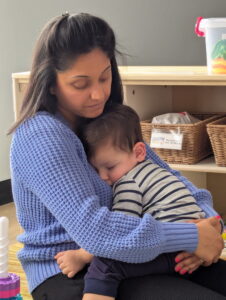Co-Regulation in Early Childhood: The Science of Emotional Support and Development

In early childhood education, emotional regulation plays a crucial role in a child’s overall development. However, self-regulation—where children independently manage their emotions, behaviors, and impulses—is a skill that takes years to develop. This is where co-regulation becomes essential. Co-regulation refers to the process in which caregivers, teachers, and parents provide emotional support, modeling, and guidance to help children learn how to regulate their emotions effectively.
What is Co-Regulation?
Co-regulation is the interactive process in which an adult or more experienced peer provides a child with the support needed to regulate their emotions, thoughts, and behaviors.
This involves three key elements:
1. A warm and responsive relationship – The caregiver provides a safe and secure attachment that reassures the child during moments of distress.
2. Modeling self-regulation skills – Adults demonstrate appropriate emotional responses, problem-solving techniques, and calming strategies.
3. Scaffolding emotional learning – The adult guides the child through difficult emotions by offering strategies, encouragement, and reassurance until the child can manage the situation independently.
Co-regulation acts as a bridge to self-regulation, helping young children develop the neural pathways necessary to handle stress, frustration, and disappointment without becoming overwhelmed.
The Science Behind Co-Regulation: Why It Matters
Brain Development and Emotional Regulation
During the early years, a child’s brain is undergoing rapid development, particularly in the prefrontal cortex, which is responsible for executive functioning skills such as impulse control, problem-solving, and emotional regulation. However, the prefrontal cortex is not fully developed until early adulthood (Goswami, 2008).
Young children primarily rely on the limbic system, the emotional center of the brain, to process experiences. When a child is overwhelmed, frustrated, or anxious, their amygdala—the brain’s “alarm system”—activates a fight, flight, or freeze response. Without support, this can lead to prolonged stress, emotional dysregulation, and behavioral challenges.
Through co-regulation, caregivers help children navigate big emotions by offering external regulation, such as soothing voices, deep breathing exercises, or calming physical touch. This reduces stress hormone levels, prevents emotional outbursts, and helps children feel safe enough to develop internal regulation mechanisms.
Attachment Theory and Emotional Security
John Bowlby’s Attachment Theory (1969) emphasizes the importance of a secure caregiver-child relationship. When children feel emotionally supported and comforted in times of distress, they develop a secure attachment, leading to greater self-confidence, emotional intelligence, and resilience.
Research shows that children who experience consistent and responsive caregiving develop strong self-regulation skills, while those who experience neglect, inconsistent discipline, or punitive responses to emotions may struggle with emotional regulation later in life (Sroufe, 2005).
By fostering co-regulation in early childhood, educators and caregivers lay the foundation for healthy social-emotional development, academic success, and overall well-being.
Benefits of Co-Regulation in Early Childhood Education
1. Supports Emotional Development
Co-regulation helps children understand and label their emotions while providing them with tools to manage frustration, anxiety, and disappointment. Instead of resorting to tantrums or aggression, children learn adaptive coping skills through guided emotional coaching.
2. Reduces Behavioral Challenges
Studies show that children who receive co-regulation support are less likely to engage in aggressive behaviors, defiance, and emotional outbursts (Murray et al., 2015). By validating emotions and teaching problem-solving techniques, caregivers help children navigate conflicts and frustrations more effectively.
3. Enhances Social Skills
Children who experience co-regulation learn how to read social cues, express emotions appropriately, and engage in cooperative play. These skills are essential for forming friendships, resolving conflicts, and developing empathy.
4. Strengthens Cognitive Development
Self-regulation is closely linked to executive functioning skills, including attention control, working memory, and impulse inhibition (Diamond, 2013). Co-regulation provides children with practice in patience, focus, and problem-solving, skills that directly impact academic success.
5. Builds Resilience and Emotional Intelligence
Children who are supported through co-regulation develop a growth mindset, recognizing that emotions are temporary and manageable. This fosters resilience, self-confidence, and emotional intelligence, preparing them for future challenges.
How Peacock Learning Academy Implements Co-Regulation
At Peacock Learning Academy, we integrate co-regulation strategies into our daily interactions with students to create a nurturing and emotionally supportive environment. Our approach includes:
1. Building Strong Relationships
We prioritize attachment-based caregiving, ensuring that each child feels safe, valued, and understood. Our teachers use gentle reassurance, positive reinforcement, and active listening to foster trust and emotional security.
2. Teaching Emotional Literacy
Through books, storytelling, and emotion charts, we help children identify and express their feelings. We also encourage the use of calming techniques like deep breathing, sensory tools, and mindfulness exercises.
3. Modeling Self-Regulation
Our educators demonstrate appropriate emotional responses by remaining calm, using positive language, and showing children how to handle frustration constructively.
4. Providing a Calm Down Space
Each classroom includes a designated calm-down corner equipped with sensory items, soft seating, and emotion-regulation tools. This allows children to self-soothe in a safe environment with the guidance of a teacher when needed.
5. Responsive Guidance
Rather than punishing emotional outbursts, we use coaching and problem-solving techniques to help children work through conflicts and big emotions. Teachers provide verbal cues, gentle redirection, and collaborative solutions to support self-regulation.
Research-Based Co-Regulation Strategies for Parents and Educators
1. Use “Name It to Tame It”
Labeling emotions helps children process their feelings. Saying, “I see that you’re feeling frustrated because the block tower fell. That must be disappointing,” helps children feel understood and teaches them emotional vocabulary.
2. Co-Regulate Before Expecting Self-Regulation
Children need external regulation before they can self-regulate. If a child is overwhelmed, provide soothing physical touch (if welcomed), calming voice tones, and reassurance rather than expecting them to calm down alone.
3. Stay Calm and Regulated Yourself
Children co-regulate best with adults who model calm behavior. If a child is having a meltdown, take deep breaths, use a soothing voice, and maintain a relaxed body posture to signal safety.
4. Offer Choices to Encourage Autonomy
Providing simple choices—such as “Would you like to take deep breaths or read a book to calm down?”—empowers children and gives them a sense of control over their emotions.
5. Encourage Mindfulness and Sensory Strategies
Simple mindfulness techniques such as blowing bubbles, stretching, or squeezing a stress ball can help children manage big emotions.
Conclusion
Co-regulation is a powerful tool that helps children build the foundational skills needed for emotional regulation, social development, and academic success. By providing consistent emotional support, modeling self-regulation, and scaffolding problem-solving skills, educators and parents can foster a generation of emotionally intelligent and resilient children.
At Peacock Learning Academy, we are committed to nurturing emotional development through responsive caregiving and co-regulation strategies. By implementing these evidence-based practices, we create a safe, supportive environment where children can thrive socially, emotionally, and academically.
References
• Bowlby, J. (1969). Attachment and Loss, Volume 1: Attachment. New York: Basic Books.
• Diamond, A. (2013). Executive functions. Annual Review of Psychology, 64(1), 135-168.
• Goswami, U. (2008). Cognitive development: The learning brain. Psychology Press.
• Murray, D. W., Rosanbalm, K., Christopoulos, C., & Hamoudi, A. (2015). Self-regulation and toxic stress: Foundations for understanding self-regulation from an applied developmental perspective. OPRE Report.
• Sroufe, L. A. (2005). Attachment and development: A prospective, longitudinal perspective. Current Directions in Psychological Science, 14(2), 70-74.
For more information about co-regulation - Rocking and Rolling. Sharing our Calm: The Role of Co-Regulation in the Infant-Toddler Classroom

Sejal Dave, Owner and Director
Peacock Learning Academy


